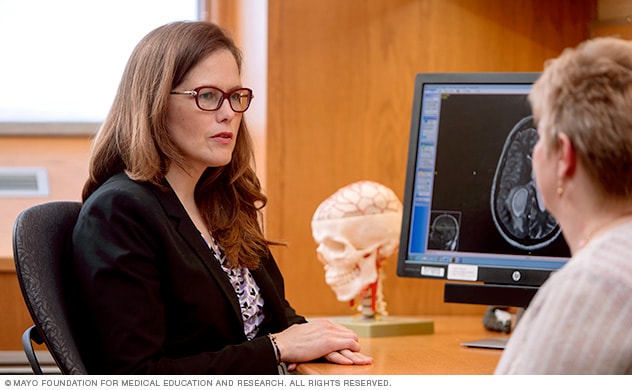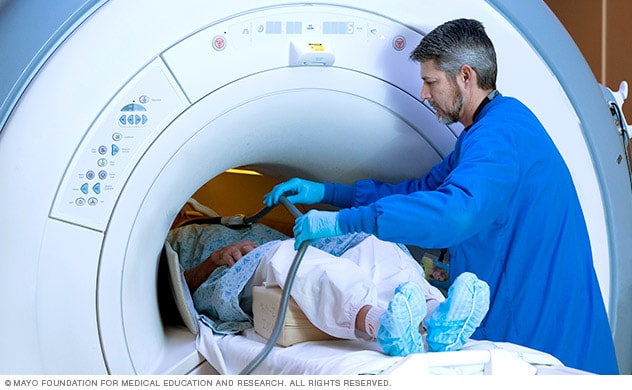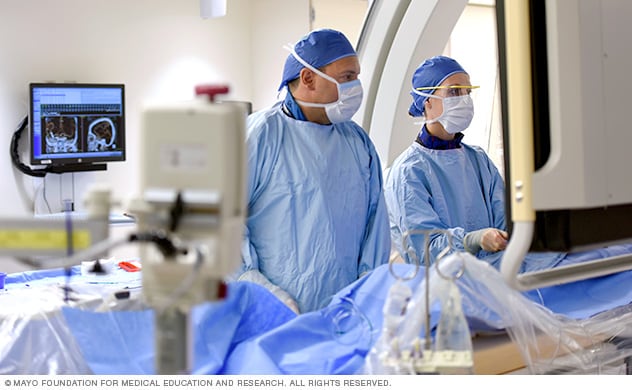Diagnosis
 Neurology consultation
Neurology consultation
A Mayo Clinic neurologist converses with a woman about her diagnosis.
Often, people with cerebral cavernous malformations (CCMs) don't show any signs or symptoms. Your diagnosis may result from brain imaging for other neurological conditions. In some cases, specific symptoms may prompt your health care provider to pursue more extensive testing.
Tests
Depending on why the condition is suspected, your health care provider may order tests to confirm CCMs or to identify or rule out other related conditions. You may have diagnostic imaging tests (radiology) to identify changes in the blood vessels. Your health care provider may also order tests if you've experienced new symptoms. The tests can determine if there's bleeding or new CCMs.
- Magnetic resonance imaging (MRI). In this test, a detailed picture is made of your brain or spine. The blood vessels in the brain may be imaged as well. Sometimes a contrast dye injected into a vein in the arm provides images of brain tissue in a slightly different way or provides images of the blood vessels in the brain (magnetic resonance angiography or magnetic resonance venography).
- Genetic testing. If you have a family history of the condition, genetic counseling and tests are helpful to identify changes associated with CCMs in genes or chromosomes.
 Brain MRI scan
Brain MRI scan
An MRI is administered to a person.
Treatment
Doctors trained in brain and nervous system conditions (neurologists and cerebrovascular neurologists), brain and nervous system surgery (neurosurgeons), brain imaging (neuroradiologists), and other specialties work with you to treat CCMs as well as other neurological conditions.
Your treatment may include:
- Observation. If you're not experiencing symptoms, your doctor may initially decide to monitor your cavernous malformation, especially since risk is generally lower for those who are non-symptomatic. Sometimes regular testing with an MRI is recommended to watch for any changes in the malformation. Let your doctor know right away about any changes in your symptoms.
- Medications. If you have seizures related to a cavernous malformation, you may be prescribed medications to stop the seizures.
- Counseling. Your doctor will review with you how other medical problems may impact a CCM. Also, talk to your doctor about how lifestyle factors and medications may affect a CCM.
- Surgery. If you're experiencing symptoms related to a cavernous malformation that can be reached surgically, your doctor may recommend surgery to remove the malformation.
 Neurosurgery for cerebral cavernous malformations
Neurosurgery for cerebral cavernous malformations
Mayo Clinic neurosurgeons remove a cavernous malformation.
If your treatment plan includes surgery, more-advanced imaging technologies may be useful. You may have a functional MRI, which measures blood flow in the active parts of the brain. Another option is tractography, which creates a map of the brain to make surgery as safe as possible.
The outlook of cerebral cavernous malformations depends on many factors, including their size, growth and whether or not they cause symptoms. Some CCMs don't cause any symptoms at all, while others can cause serious bleeding in the brain.
Potential future treatments
Several imaging technology areas hold promise for improving predictions of the course of disease in some cases and for enhancing the level of information available about a particular individual's disease state. They include imaging through quantitative susceptibility mapping (QSM) and permeability imaging using dynamic contrast-enhanced MRI.
There are several medications being tested in clinical trials to see if a medication — rather than surgery — could reduce the chance of further bleeding. Talk to your doctor about which clinical trials may be available to you.
Clinical trials
Explore Mayo Clinic studies testing new treatments, interventions and tests as a means to prevent, detect, treat or manage this condition.
Preparing for your appointment
See your health care provider if you have any signs or symptoms that worry you. If a cerebral cavernous malformation is suspected, a referral to an experienced specialist can provide the best outcome.
Here's some information to help you get ready for the appointment, and what to expect from your health care provider.
What you can do
- Keep a detailed symptoms calendar. Each time a symptom occurs, write down the time, what you experienced and how long it lasted.
- Write down key personal information, including any major stresses or recent life changes.
- Make a list of all medications, vitamins or supplements you're taking.
- Take a family member or friend along. Sometimes it can be difficult to remember all the information provided to you during an appointment. Someone who accompanies you may remember something that you missed or forgot.
- Bring any recent brain scans in a CD to your appointment.
Also, if you've experienced seizures, your doctor may want to ask questions of someone who has witnessed them. It's common not to be aware of everything that happens when you experience one.
Write down questions to ask your doctor
Preparing a list of questions will help you make the most of your time with your doctor. List your questions from most important to least important in case time runs out. Most of these should be covered during your visit. Here are some examples of good questions to ask your doctor.
General questions
- How many cavernous malformations do I have?
- Where is it, or where are they located?
- What functions do the area or areas of the brain perform?
- Should I have genetic tests for hereditary CCMs?
- Should my children or anyone else in my family be tested?
Management and observation
- How often will I need follow-up tests?
- How often will I follow up with you?
Surgery (to remove a malformation)
- How long would you estimate I'd be in surgery?
- How long does surgery recovery usually take?
- How long should I plan to be in the hospital?
Surgical background
- How many CCMs have you seen, and how many have you treated?
- Does your institution have a cerebrovascular specialty practice?
Other questions may be useful for your needs. The Angioma Alliance offers an extensive set of suggested questions.
In addition to the questions you've prepared to ask your doctor, don't hesitate to ask questions during your appointment at any time if you don't understand something.
What to expect from your doctor
Your doctor is also likely to ask you a number of questions:
- When did you first begin experiencing symptoms (seizures, hemorrhage or bleeding, weakness in arms or legs, vision problems, balance problems, speech problems, difficulty with memory and attention, headaches, and so on)?
- Do your symptoms come and go (intermittent) or are they persistent (present all the time)?
- Do your symptoms seem to be triggered by certain events or conditions?
What you can do in the meantime
Certain conditions and activities can trigger seizures, so it may be helpful to:
- Avoid excessive alcohol consumption
- Avoid nicotine usage
- Get enough sleep
- Reduce stress
Dec. 14, 2022